Enlargement countries - transport statistics
Data extracted in April 2023.
Planned article update: May 2024.
Highlights
Montenegro had the highest motorisation rate among candidate countries and potential candidates, with 358 passenger cars per 1 000 inhabitants in 2021, compared with 567 in the EU.
In 2021, the number of persons killed in road accidents per inhabitants was the highest in Montenegro among Western Balkans and Türkiye, with 8.9 persons per 100 000 inhabitants, compared with 4.2 for the EU in 2020 (no 2021 data available).
Motorisation rate, 2011, 2020 and 2021
This article is part of an online publication and provides information on a range of transport statistics for the Western Balkans and Türkiye and compares this with the corresponding data for the European Union (EU). Within this region, Bosnia and Herzegovina, Montenegro, North Macedonia, Albania, Serbia and Türkiye are candidate countries, while Kosovo has the status of potential candidate.
Data for Georgia, Moldova and Ukraine, granted candidate status or European perspective by the European Council in June 2022, are not included in this article; Statistics Explained articles on the European Neighbourhood Policy-East countries are available here.
The article provides information in relation to a range of transport statistics, including the density of the road transport network; road accidents; road and rail passenger transport; and an analysis of freight transport.
* This designation is without prejudice to positions on status, and is in line with UNSCR 1244/1999 and the ICJ Opinion on the Kosovo Declaration of Independence.
Full article
Road network
Table 1 presents the density of the road transport network in relation to total land area, an indicator that is comparable between territories. Montenegro recorded the highest road density (all roads, including motorways) among Western Balkans and Türkiye, with 703 m of road per square kilometre (km2) of land area in 2021. Serbia (2020 data) and North Macedonia followed with 567 m per km2, each. In Türkiye, the road network density was 324 m per km2 in 2020 (no 2021 data available). In Kosovo, Bosnia and Herzegovina and Albania, roads were spread more thinly across each territory, at 199 m (2020 data), 177 m and 124 m per km2 in 2021, respectively. For comparison, there was a much higher density of roads in the EU, estimated to be 856 m per km2 in 2021, taking into account that data from Germany and Greece are not included.
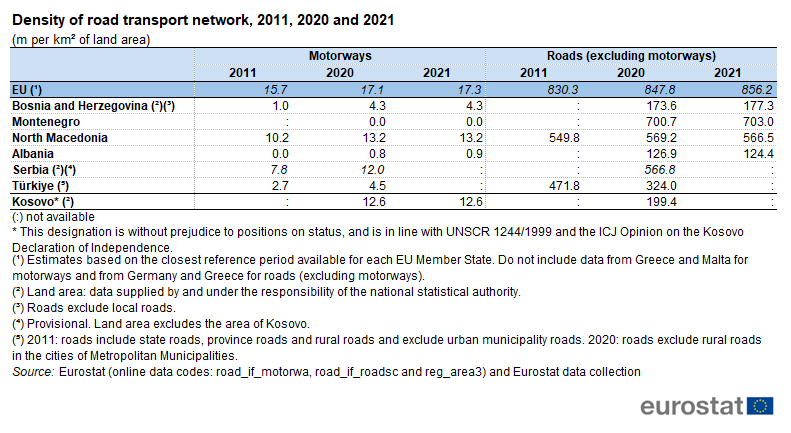
(m per km2 of land area)
Source: Eurostat (road_if_motorwa), (road_if_roadsc) and (reg_area3) and Eurostat data collection
The motorisation rate is measured as the number of passenger cars per 1 000 inhabitants. As shown in Figure 1, the highest motorisation rates amongst Western Balkans and Türkiye were observed in Montenegro, at 358 passenger cars per 1 000 inhabitants in 2021, in Serbia, at 325 per 1 000 inhabitants in 2021 and in North Macedonia, at 260 per 1 000 inhabitants in 2021. The motorisation rate in Bosnia and Herzegovina was 256 passenger cars per 1 000 inhabitants in 2021. In 2021, the lowest motorisation rates among Western Balkans and Türkiye were found in Albania, Kosovo and Türkiye, with 210, 181 and 164 passenger cars per 1 000 inhabitants, respectively. In 2021, the motorisation rate in the EU stood at 567 passenger cars per 1 000 inhabitants.
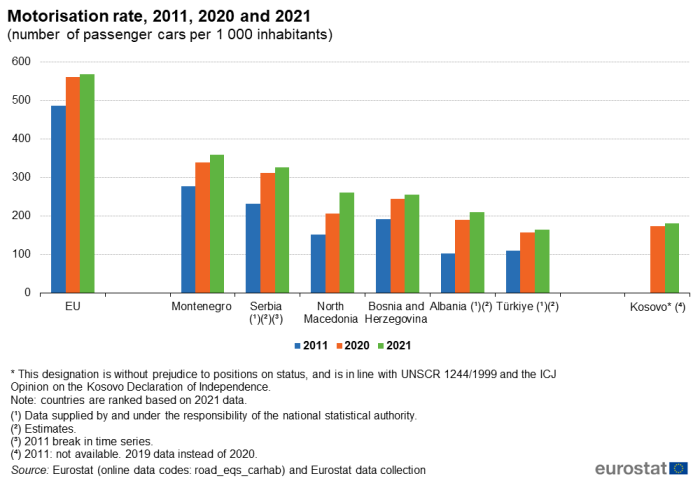
(number of passenger cars per 1 000 inhabitants)
Source: Eurostat (road_eqs_carhab), (tran_r_vehst) and (demo_gind) and Eurostat data collection
Since 2011, there was faster growth in the motorisation rate in all Western Balkans and Türkiye than in the EU. One of the Western Balkans countries with the lowest motorisation rates - Albania - recorded the fastest expansion in car ownership since 2011. Albania had the highest annual average growth rate of change at 7.3 % between 2011 and 2021. In North Macedonia, the annual average growth rate was 5.5 % between 2011 and 2021. In Türkiye, the annual average motorisation growth rate was 4.1 %; in Serbia, 3.5 %; and in Bosnia and Herzegovina and Montenegro the rate increased by an annual average of 2.9 % and 2.6 %, respectively, between 2011 and 2021. In the EU, there was an annual average increase of 1.6 % in car ownership over the period 2011-2021, or 81 additional cars per 1 000 inhabitants over the whole period. There is no 2011 data available for Kosovo.
Figure 2 illustrates the numbers of persons killed in road accidents per 100 000 inhabitants for 2011, 2020 and 2021. No data is available for Kosovo. In almost all Western Balkans and Türkiye for which data is available for 2011 and 2021, there has been a considerable decline in the rate of road fatalities; the only exception being Türkiye, where the rate of road fatalities increased, but this may be due to a change in definition, which is explained in the next paragraph.
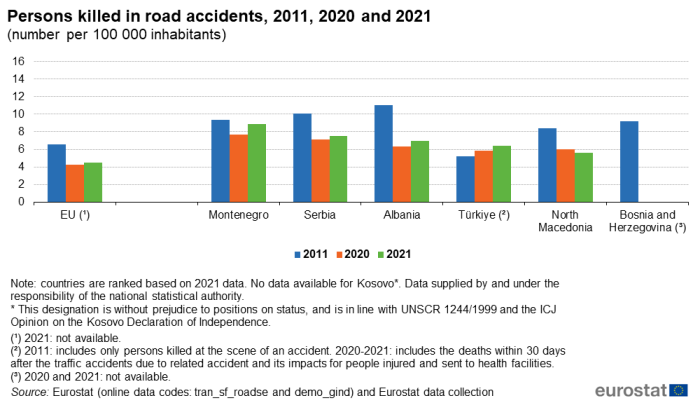
(number per 100 000 inhabitants)
Source: Eurostat (tran_sf_roadse) and (demo_gind) and Eurostat data collection
Montenegro had the highest number of persons killed in road accidents per 100 000 inhabitants among Western Balkans and Türkiye at 8.9 in 2021 but this figure was 5 % lower than in 2011, when it was 9.4. The next highest observation was in Serbia, at 7.6 road fatalities per 100 000 inhabitants, followed by Albania, at 7.0 road fatalities per 100 000 inhabitants in 2021. Serbia's fatality rate declined by 25 % from 2011, when it was 10.0. Albania's road accident fatality rate recorded a decrease by 37 % compared with 2011 when it was 11.1, the highest among Western Balkans and Türkiye. Türkiye's rate in 2021 was 6.4; this rate is higher than it was in 2011 (5.2) but it has to be noted that the 2011 data includes only persons killed at the scene of an accident while in 2021 data includes the deaths within 30 days after the traffic accidents due to related accident and its impacts for people injured and sent to health facilities. North Macedonia had the lowest number of persons killed in road accidents per 100 000 inhabitants among Western Balkans and Türkiye at 5.6 in 2021 a decline of 33 % from the rate 8.4 observed in 2011, In the EU, the number of persons killed in road accidents per 100 000 inhabitants in 2011 and 2021 were 6.5 and 4.5, respectively, meaning that there was a decline of 32 % over the period.
Road and rail passenger transport
Table 2 shows road and rail passenger transport measured in million passenger-kilometres, performed on the national territory by any passenger road or rail vehicle (regardless of their place of registration). The road passenger data for Montenegro shows only passengers on board motor coaches and buses and thus does not measure the use of private cars or passengers in taxis, which are included in the data for other candidate countries and potential candidates.
Türkiye's road passenger transport was estimated at 288 992 million passenger-kilometres in 2020 (no 2021 data available), an annual average growth of 2.0 % from the 2011 figure of 242 265. North Macedonia saw a major increase in road transport over the period 2011 to 2021, from 1 640 million to 11 441 million passenger-kilometres, an annual change rate of 21.4 %. Serbia's road passenger traffic increased by 0.4 % a year on average over the period 2011-2017 (more recent data is not available), from 4 151 to 4 255 million passenger-kilometres. In Montenegro, passengers on board of motor coaches and buses accounted for 32 million passenger-kilometres in 2021, down from 80 million in 2011, an annual decrease of 8.7 %. Bosnia and Herzegovina's most recent road data date from 2016. In that year, 1 706 million passenger-kilometres were travelled by road, down from 1 926 million in 2011, an annual average decline of 2.4 %. There is no data available for road passenger transport in Albania nor in Kosovo. There is no EU aggregate available for road passenger transport.
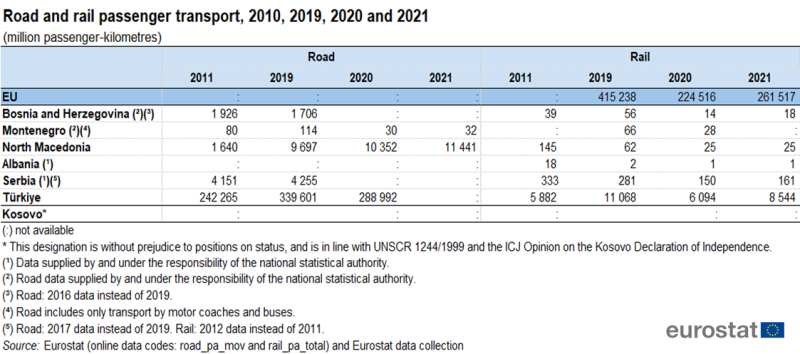
(million passenger-kilometres)
Source: Eurostat (road_if_motorwa), (road_pa_mov), (rail_pa_total) and Eurostat data collection
In 2021, rail passenger transport was still impacted by the COVID-19 pandemic. All Western Balkans and Türkiye for which data is available, except North Macedonia, showed a substantial rise in rail passenger transport performance between 2020 and 2021. Türkiye and Albania reported rises by 40.2 % and 37.0 %, respectively, though Albania increased from the smallest value. Bosnia and Herzegovina and Serbia increased by 29.9 % and 7.4 %, respectively. North Macedonia recorded only 0.4 % growth in 2021 compared with 2020. When comparing 2021 with 2019, the last year before the COVID-19 pandemic, substantial falls can still be observed in all Western Balkans and Türkiye. The largest decreases were observed in Bosnia and Herzegovina (-67.1 %), Albania (-60.5 %) and North Macedonia (-59.1 %); followed by Serbia (-42.8 %) and Türkiye (-22.8 %). There is no 2021 data available for Montenegro where rail passenger transport decrease by 57.6 % in 2020 compared with 2019, from 66 million passenger-kilometres in 2019 to 25 million passenger-kilometres in 2020. In the EU, rail passenger transport also increased (+16.5 %) in 2021 compared with 2020, from 224.5 million passenger-kilometres to 261.5 million passenger-kilometres, while the number of passenger-kilometres were still -37.0 % lower in 2021 compared with pre-pandemic year 2019. In Türkiye, rail accounted for 8 544 million passenger-kilometres in 2021. Rail passenger transport increased by 3.8 % annually on average from 2011, when there were 5 882 million passenger-kilometres. When looking at the period 2011-2019, the annual average growth was 8.2 %. In Albania, rail passenger transport declined from 18 to 2 million passenger-kilometres over the period 2011-2019, an average annual change of -23.8 %. North Macedonia saw a significant decrease in rail passenger transport over the period 2011-2019, from 145 to 62 million passenger-kilometres, an average annual change rate of -10.1 %; in 2021, rail accounted for 25 million passenger-kilometres. Serbia's rail passenger traffic decreased by 3.3 % annually between 2012 (2011 data not available) and 2019, from 333 to 281 million passenger-kilometres; in 2021, rail accounted for 161 million passenger-kilometres. In Bosnia and Herzegovina, rail passenger traffic increased from 39 million passenger-kilometres in 2011 to 56 million passenger-kilometres in 2016 (2019 data not available) average 7.4 % annually between those two periods, and it dropped down to 18 million passenger-kilometres in 2021. There is no rail data available for Kosovo. There is no EU aggregate available for 2011.
The market share of passenger transport was clearly dominated by road transport in Western Balkans and Türkiye for which data is available for 2021 or 2019. North Macedonia registered the highest market share of road passenger transport, with 99.8 %, whereas rail passenger transport represented only a small fraction (0.2 %). Türkiye and Bosnia and Herzegovina recorded similar market shares: 97.9 % and 96.8 % for road passenger transport; nevertheless, road data for Bosnia and Herzegovina refers to 2016 (more recent data is not available). Serbia followed closely, with a share of 93.8 % for road passenger transport, and 6.2 % for rail passenger transport (road data refers to 2017 as more recent data is not available). Montenegro's passenger transport was more balanced between the two modes of transport: road passenger transport accounted for 51.4 % in 2020 (no rail data available for 2021). Not enough or no data available for comparison for Albania, Kosovo and the EU.
Freight transport
Tables 3 and 4 show transport of freight measured in tonne-kilometres for road and rail (performed on the national territory by any road or rail vehicle, regardless of their place of registration), but in tonnes for sea and air. The weight of goods transported by rail is the gross-gross weight. This includes the total weight of the goods, all packaging, and the tare weight of the container, swap-body and pallets containing goods; in the case of rail freight transport, it also includes road goods vehicles that are carried by rail. By contrast, the weight measured for air, maritime and road freight transport is the gross weight, excluding the tare weight.
In Türkiye, road freight transport in 2021 accounted for 311 818 million tonne-kilometres, showing an average annual increase of 4.4 % from a decade before, when it was 203 072 million tonne-kilometres. Rail freight transport was 14 621 million tonne-kilometres in 2021, an average annual increase of 2.6 % from 2011, when it was 11 303 million tonne-kilometres. Freight loaded and unloaded in maritime Turkish ports accounted for 519 907 thousand tonnes in 2021, up from 359 082 thousand tonnes in 2011, an average annual increase of 3.8 %. Air freight increased even faster, from 603 thousand tonnes loaded and unloaded in 2011 to 1 742 thousand in 2021, an average annual growth of 11.2 %; between 2020 and 2021 the air freight raised by 24.5 %.
In Bosnia and Herzegovina, road freight transport also increased over the period 2011-2021, from 2 309 million tonne-kilometres in 2011 to 4 405 million tonne-kilometres in 2021, an average annual increase of 6.7 %. Rail freight transport accounted for 1 181 million tonne-kilometres in 2021 an increase of 14.7 % from 2020. Rail freight data is not available for 2011, while there is no sea freight data available. Air freight loaded and unloaded in 2021 accounted for 2.3 thousand tonnes, an average annual increase of 3.9 % compared with 2012 (2011 data is not available), while a decrease of 11.4 % observed between 2020 and 2021.
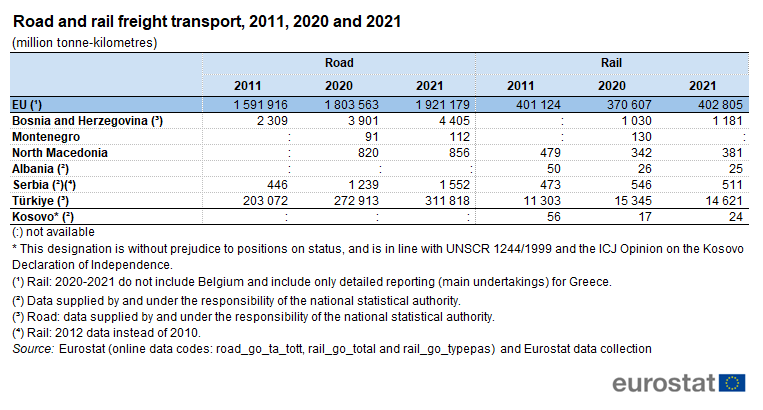
(million tonne-kilometres)
Source: Eurostat (road_go_ta_tott), (rail_go_total), (rail_pa_typepas) and Eurostat data collection
Serbian road freight transport increased on average by 13.3 % a year from 446 million tonne-kilometres in 2011 to 1 552 million tonne-kilometres ten years later. Rail freight data is not available for 2011 but when looking at the period 2012-2021, there was an annual average growth of 0.9 %, up to 511 million tonne-kilometres in 2021 from 473 million tonne-kilometres in 2012. For air freight, data is also not available for 2011. In 2021, 14.8 thousand tonnes of freight were loaded and unloaded in Serbian airports, which is 11.4 % lower than in previous year. There are no maritime ports in Serbia.
In North Macedonia, 856 million tonne-kilometres of freight were hauled by road in 2021, which is 4.4 % more than in previous year. There is no road data available for 2011. Rail freight accounted for 381 million tonne-kilometres in 2021, down from 479 million tonne-kilometres in 2011, an annual rate decline of 2.3 %. In 2021, 3.0 thousand tonnes of air freight were loaded and unloaded in North Macedonia, which shows 42.5% increase compared with 2020; there is no data available for 2011. There are no maritime ports in North Macedonia.
In Montenegro, road freight accounted for 112 million tonne-kilometres in 2021, an increase by 23.1 % compared with the previous year, while rail freight recorded 130 million tonne-kilometres in 2020 (no 2021 data available). Road and rail data are not available for 2011. In 2021, 1 859 thousand tonnes of freight were loaded and unloaded in maritime Montenegrin ports, an annual average growth rate of 5.3 % over the period 2012-2021 (2011 data is not available). In 2021, 0.5 thousand tonnes of air freight were loaded and unloaded in Montenegro; air data is not available for 2011.
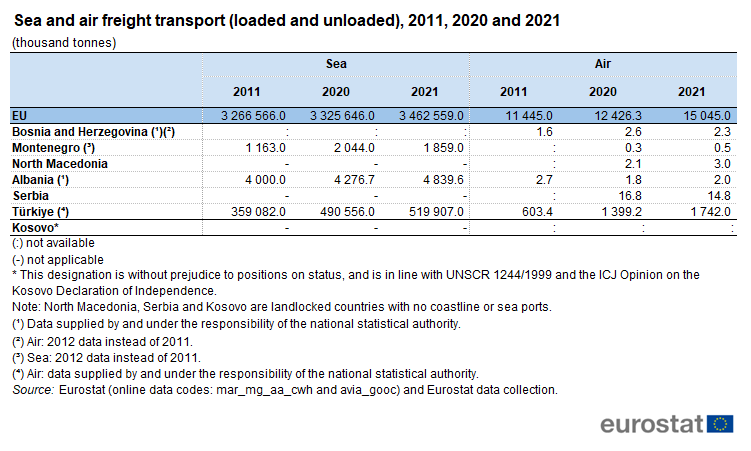
(thousand tonnes)
Source: Eurostat (mar_mg_aa_cwh), (avia_gooc) and Eurostat data collection
Road freight transport data is not available for Albania. Rail freight transport declined by half from 50 million tonne-kilometres in 2011 to 25 million tonne-kilometres in 2021, an annual average fall of 6.7 % over the period 2011-2021. Maritime freight recorded 1.9 % annual average growth over the decade with 4 000 thousand tonnes loaded and unloaded in 2011 and 4 840 thousand tonnes in 2021. Air freight showed a substantial decline in 2020 to 1.8 thousand tonnes loaded and unloaded from 2.7 thousand tonnes in 2011 and 13.3% increase up to 2.0 thousand tonnes between 2020 and 2021.
Kosovo data is available only for rail. In 2011, 56 million tonne-kilometres were hauled, falling to 17 million tonne-kilometres in 2020 and rising up to 24 million tonne-kilometres in 2021, an average annual decline of 8.3 % over the period 2011-2021.
In the EU, road freight haulage increased from 1 591 916 million tonne-kilometres in 2011 to 1 921 179 million tonne-kilometres in 2021, an average annual increase of 1.9 %. Rail freight increased slightly over the period 2011-2021: from 401 124 million tonne-kilometres in 2011 to 402 805 in 2021. Despite a substantial decrease observed in 2020 compared with 2011 (-7.6 %), a minor average annual growth was recorded over the period 2011-2021. Maritime freight increased from 3 267 million tonnes loaded and unloaded in 2011 to 3 463 million tonnes in 2021, an average annual increase of 0.6 . Air freight increased slightly faster at an average annual rate of 2.8 % over 2011-2021. The figure at the start of this period was 11 445 thousand tonnes loaded and unloaded and 15 045 thousand tonnes in 2021. A substantial increase was observed in 2021 compared with 2020 (+21.1 %).
Source data for tables and graphs
Data sources
Data for Western Balkans and Türkiye are collected for a wide range of indicators each year through a questionnaire that is sent by Eurostat to them. A network of contacts has been established for updating these questionnaires, generally within the national statistical offices, but potentially including representatives of other data-producing organisations (for example, central banks or government ministries).
For the EU, the development of passenger and freight transport statistics is based upon a raft of framework legislation and implementing legislation, generally organised according to the mode of transport under consideration. These statistics are made available free-of-charge on Eurostat's website.
Transport statistics are available with an annual frequency and a time series generally beginning in the early 1990s. The majority are based on movements in each reporting country, regardless of the nationality of the vehicle or vessel involved (the 'territoriality principle').
Tables in this article use the following notation:
| Value in italics | data value is forecasted, provisional or estimated and is therefore likely to change; |
| : | not available; |
| – | not applicable. |
Context
The European Union's mobility and transport objectives are set out in the European Commission Directorate-General for Mobility and Transport's Strategic Plan 2020-2024:
1: A sustainable transport area that reduces transport impact on the environment, provides healthier and cleaner alternatives to mobility and increases the uptake of sustainable alternative transport fuels for land, waterborne and air both in the EU and globally.
2: A smart and innovative transport sector that makes the most of digitalisation and automation, supported by adequate funding.
3.1: A fully integrated and connected Trans-European Transport network with appropriate funding for a robust and modern European transport infrastructure with fully restored connectivity.
3.2: An efficient and accessible internal market for transport that drives economic recovery and is governed by clear rules that are applied and enforced consistently.
4: A European Union that acts united in cooperation with key partners and neighbours to improve connectivity links, open-up new market opportunities and promote high safety and security standards.
5: High levels of transport safety and security are ensured and new security and safety challenges are addressed.
Information concerning the current statistical legislation on transport statistics can be found here.
While basic principles and institutional frameworks for producing statistics are already in place, Western Balkans and Türkiye are expected to increase progressively the volume and quality of their data and to transmit these data to Eurostat in the context of the EU enlargement process. EU standards in the field of statistics require the existence of a statistical infrastructure based on principles such as professional independence, impartiality, relevance, confidentiality of individual data and easy access to official statistics; they cover methodology, classifications and standards for production.
Eurostat has the responsibility to ensure that statistical production of Western Balkans and Türkiye complies with the EU acquis in the field of statistics. To do so, Eurostat supports the national statistical offices and other producers of official statistics through a range of initiatives, such as pilot surveys, training courses, traineeships, study visits, workshops and seminars, and participation in meetings within the European Statistical System (ESS). The ultimate goal is the provision of harmonised, high-quality data that conforms to European and international standards.
Additional information on statistical cooperation with the enlargement countries is provided here.
Direct access to
- Enlargement countries — statistical overview — online publication
- Statistical cooperation — online publication
- Transport
- Transport statistics introduced
- Statistical books/pocketbooks
- Key figures on enlargement countries — 2019 edition
- Key figures on enlargement countries — 2017 edition
- Key figures on the enlargement countries — 2014 edition
- Energy, transport and environment indicators — 2020 edition
- Factsheets
- Basic figures on the candidate countries and potential candidates — Factsheets — 2023 edition
- Basic figures on Western Balkans and Türkiye — Factsheets — 2022 edition
- Basic figures on enlargement countries — Factsheets — 2021 edition
- Leaflets
- Basic figures on enlargement countries — 2020 edition
- Basic figures on enlargement countries — 2019 edition
- Basic figures on enlargement countries — 2018 edition
- Basic figures on enlargement countries — 2016 edition
- Energy and transport statistics for the enlargement countries — 2018 edition
- Transport, see:
- Railway transport (rail)
- Railway transport measurement - goods (rail_go)
- Road transport (road)
- Road transport infrastructure (road_if)
- Road freight transport measurement (road_go)
- Maritime transport (mar)
- Maritime transport - main annual results (mar_m)
- Air transport (avia)
- Air transport measurement- freight and mail (avia_go)
- Railway transport measurement - passengers and freight (ESMS metadata file — rail_pa_esms)
- Common Questionnaire for Inland Transport Statistics (ESMS metadata file — rail_if_esms)
- Road freight transport measurement (road_go) (ESMS metadata file — road_go_esms)
- Maritime transport (mar) (ESMS metadata file — mar_esms)
- Air transport measurement – passengers (avia_pa), freight and mail (avia_go), airport traffic (avia_tf) and regional statistics (avia_rg) (ESMS metadata file — avia_pa_esms)